| |
5 October 2022 |
|
“James Bond has only
one father – Ian Fleming.”
|
|
|
Screenwriter JOHANNA
HARWOOD’s important role in the first two James Bond films has for too
long been brushed aside in many 007 histories. Author FRÉDÉRIC ALBERT LEVY
[with additional research by KEVIN HARPER] sets the record straight in this exclusive interview conducted in the 60th
anniversary year of the James Bond film series. |
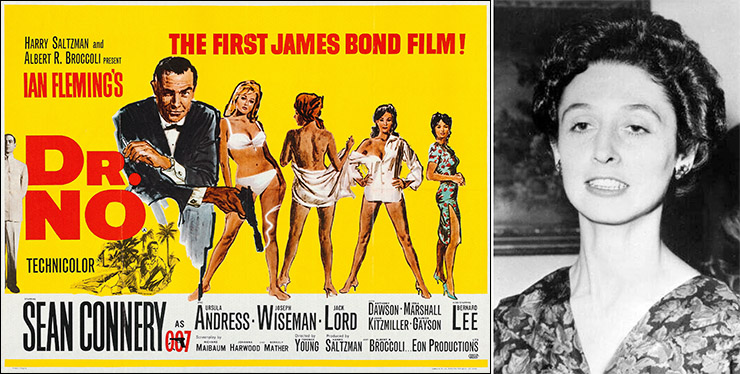 |
|
What made you decide
to go and study film at the Paris IDHEC (Institut des Hautes Études
Cinématographiques)? Weren’t there such film schools in English-speaking
countries? Was it your film studies in Paris that made you become
bilingual or were you already bilingual?
I went to Paris because there was no film school in England at the time.
There was one in Italy – at Cinecittà – but I didn’t speak a word of
Italian. There were also courses in some American universities, but for me
going to the States was out of the question: the costs were far too high.
I still don’t consider
myself bilingual! I learned the basics of French at school, with a year of
modern French at the University of Lausanne as a complement. That was
enough to understand the teachers at IDHEC. Some of them, moreover,
accepted papers handed to them in English. |
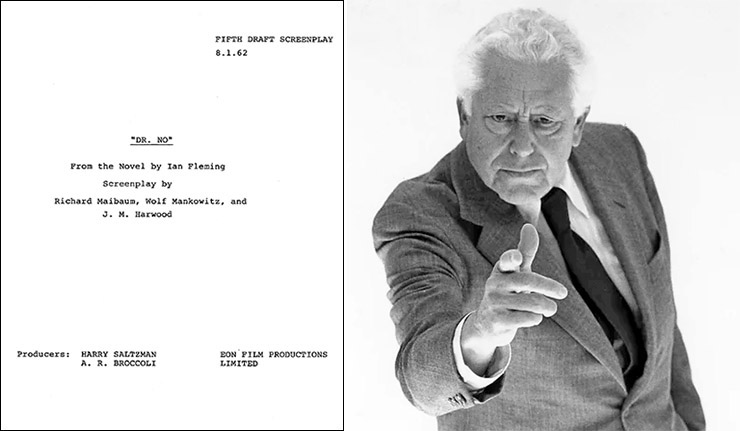 |
|
ABOVE: (left) Dated
January 8, 1962 the fifth draft screenplay of Dr. No was credited
to Richard Maibaum, Wolf Mankowitz and J. M. Harwood. Mankowitz
was paid £7,000 for his contribution to the screenplay although he
ultimately withdrew from the project, and did not receive credit
on the finished film. Johanna Harwood was paid just £300 for her work
on Dr. No, and subsequently worked on the screenplay for
EON Productions next two films, Call Me Bwana and From
Russia With Love, both released in 1963. (right) American
screenwriter Richard Maibaum who would be credited on 13 James
Bond films 1962-1989. |
|
|
|
As the ‘legend’ goes,
you left the Bond series after From Russia With Love because of
Terence Young and Richard Maibaum’s outrageously sexist behaviour. Did
Maibaum really object to your name being mentioned in the credits?
I never worked with Richard Maibaum – or even met him. So, he could never
be “outrageously sexist” with me. As I had left EON long before From
Russia With Love was released, I only recently learned that he had
objected to me being credited.
As for Terence Young, we
only worked together for one afternoon. Harry Saltzman had asked us to
work together to rewrite my first draft for Russia (Maibaum had not
joined the party yet). With my script open on the table, pencil in hand,
Young worked all afternoon without speaking to me, then he put down his
pencil, pushed the script away and said, “There! That’s better, don’t you
think?” The question was purely rhetorical.
I immediately went to
tell Harry Saltzman that if I stayed, he would have to pay two salaries
instead of one for the same result, since collaboration was a word
that obviously didn’t belong in Terence Young’s lexicon. It was a line of
reasoning Saltzman understood perfectly well! However, I wouldn’t say that
Young’s behaviour was particularly sexist. He just thought he was better
than everyone else. After I left, it was Maibaum who took over. |
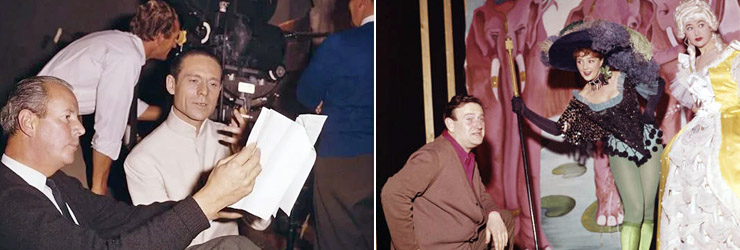 |
|
ABOVE: (left)
Pinewood Studios March 1962 - Director Terence Young
(1915-1994) goes over the script of Dr. No with American
actor Joseph Wiseman (1918-2009) who played the titular villain
in the first James Bond film. (right) English writer and
playwright Wolf Mankowitz (1924-1998) pictured on stage with two
chorus girls during a rehearsal of his new musical Belle
(or The Ballad of Dr Crippen) at the Strand Theatre in
London in May 1961. The Music-Hall show co-written with Dr. No
composer Monty Norman (1928-2022) and closed after just 44
performances. One of the financial investors of Belle was
Albert R. Broccoli (1909-1996), who despite the show’s critical
and commercial flop promised to work with Monty Norman again. |
|
|
|
Once interviewed by a
journalist who said, "You’re one of the fathers of James Bond", Terence
Young abruptly interrupted him to rephrase his sentence: "No, the
father of James Bond". What do you think of this claim?
Young claimed to be the father of James Bond. I think you have the essence
of the man in his line. James Bond has only one father – Ian Fleming.
|
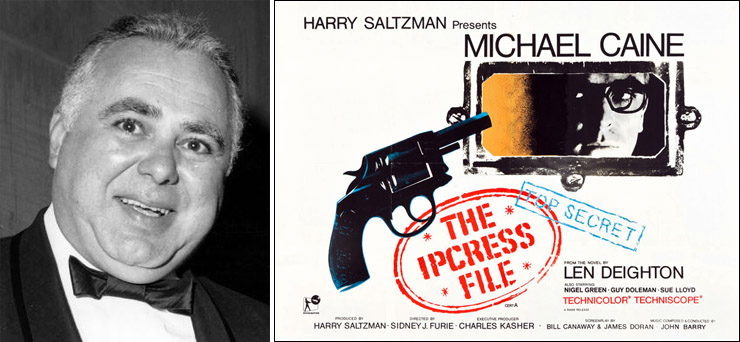 |
|
ABOVE: (left)
Canadian producer Harry Saltzman (1915-1994) who took out an
option on Ian Fleming's James Bond novels in 1961. Saltzman
would partner with Albert R. Broccoli and formed EON
Productions - the company still responsible for making the James Bond films. Saltzman parted company with Broccoli in
1975 as a result of personal financial difficulties. (right)
The UK quad-crown poster for The Ipcress File (1965)
designed by Eric Pulford (1915-2005) - the first of the ‘Harry
Palmer’ (un-named in the Len Deighton source novels) series of
films starring Michael Caine. The screen rights to the ‘Harry
Palmer’ novels
are still retained by Saltzman's family, and a new ITV
Television adaptation of The Ipcress File was broadcast
in 2022. |
|
|
|
|
Harry Saltzman, it
seems, was much more courteous to you than Young and Maibaum. Why did you
work uncredited on The Ipcress File? And, given your ties to
France, didn’t you work on Costa-Gavras’ Shock Troops, also
produced in 1967 by Saltzman?
Courteous is not a word that could be applied to Harry Saltzman. But he
wasn’t a sexist either. He was only interested in the results. He didn’t
care where they came from. I wrote the first script for The Ipcress
File long before the film was made. The same goes for Shock Troops.
When these two films were finally made, I was no longer part of the
production and did not follow the shooting. |
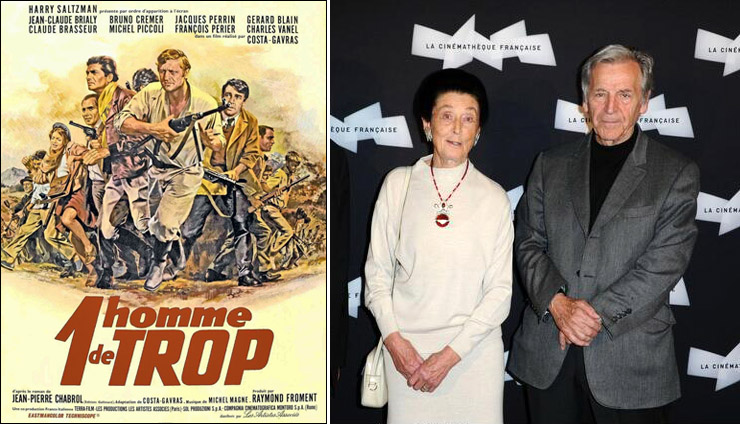 |
|
ABOVE: (left)
Produced by Harry Saltzman Un homme de trop (released in the
USA in 1968 as Shock Troops) was a 1967 French-Italian
action drama film directed by Greek-born Costa-Gavras. The poster
art was by celebrated Italian artist Jean Mascii
(1926-2003), who had painted the stylish French posters for the
early James Bond films starring Sean Connery. (right) Johanna
Harwood and Constantin Costa-Gavras (1933- ) [pictured above
right] attended a special
screening of the restored print of Plein Soleil (1960) at
Cinematheque Francaise in Paris, France June 3, 2013. Plein
Soleil (1960) [released in the UK and USA in 1961 as Purple
Noon] which was directed by Johanna's husband René Clément
(1913-1996). |
|
PHOTOGRAPH/AURORA
MARECHAL |
|
|
|
What was your
relationship like with Albert R. Broccoli?
I saw very little of Broccoli. He was more concerned with management
issues, with the administrative aspects of the production, while Saltzman
was the big producer, getting involved in all the little details. |
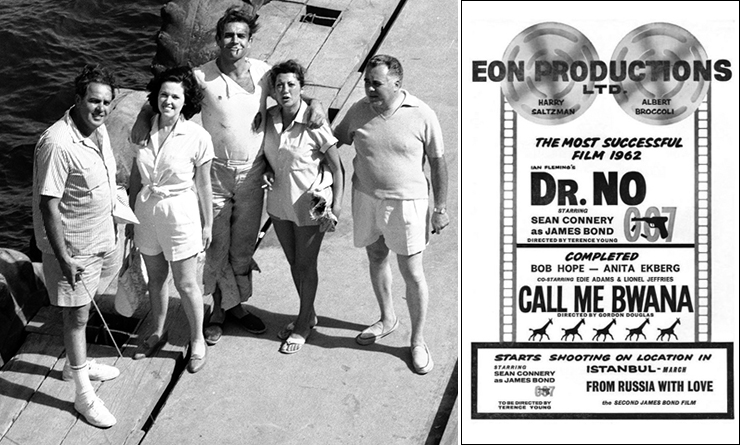 |
|
ABOVE: (left) [L-R]
Dr. No co-producer Albert R. ‘Cubby’ Broccoli, his wife
Dana, actor Sean Connery, and Jacqueline Saltzman with her husband
Harry on location at Reynold's Bauxite docks in Jamaica, which
stood in for the fictional Crab Key hideout of the villainous
Doctor No. (right) Variety Trade magazine advertisement
announcing the start of production on the second James Bond film
From Russia With Love (1963) and completion of the two
previous EON Productions titles. Screenwriter Johanna Harwood
worked on all three productions. |
|
|
|
Why do quite a few
seemingly reliable sources claim that you worked on Goldfinger when
this wasn’t the case?
I had absolutely nothing to do with Goldfinger. I think these
“reliable sources” you speak of are wrong from time to time. And, once
information is published, it is easier for others to copy it than to
verify it – hence the repeated errors. |
 |
|
What exactly was your
contribution to Dr. No and From Russia With Love? Did you
ever meet Ian Fleming? Were you already familiar with Fleming’s novels
before they were adapted for the screen?
I wrote the first screenplay for Dr. No, which enabled EON
Productions to obtain a distribution contract and a financial advance from
United Artists, and thus to hire two well-known screenwriters to rework my
script – Richard Maibaum, who had already worked for Broccoli on The
Red Beret, and Wolf Mankowitz, a very popular English writer at the
time. They were the ones who made Doctor No a monkey! Faced with this bad
surprise, the producers asked me to rewrite my first script, incorporating
everything that could be saved from the Maibaum/Mankowitz version.
At one point there was a
version of Dr. No in which Doctor No was an ape! Maibaum and
Mankowitz took on this heavy responsibility as best they could! Mankowitz,
once the film turned out to be a success, spread the rumour that he had
expressly asked not to be credited! Richard Maibaum fared better. By the
way, if I had known that he was going to contest the presence of my name
in the credits of From Russia With Love, I could have contested his
presence for Dr. No. |
 |
|
ABOVE: (left)
British writer John Evan Weston-Davies (1909-1996), known as Berkely Mather. (centre) Mather's second novel The Pass Beyond
Kashmir (1960) was glowingly endorsed by James Bond author Ian
Fleming, with the film rights later purchased by Harry
Saltzman & Albert R. Broccoli for Columbia Pictures in 1963. The
proposed film would have starred Sean Connery and Honor Blackman,
and gone into production in late 1964 after they had completed
Goldfinger (1964) - with Berkely Mather also writing the
screenplay. (right) American screenwriter Richard Maibaum
(1909-1991) chats with author Ian Fleming (1908-1964) as The
Duke and Duchess of Bedford look on. The meeting took place at
Pinewood Studios on April 1, 1963 at a party hosted by EON
Productions to celebrate the start of filming on From Russia
With Love, and publication of Ian Fleming's 10th James Bond
novel ON HER MAJESTY’S SECRET SERVICE. |
|
|
|
My second script seemed
to be satisfactory, since it was the one used to prepare the shooting. But
then I learned that Berkely Mather, a writer who had just published The
Pass Beyond Kashmir, a best-selling novel about the British in India,
had been asked to “masculinise” the dialogue. It should be noted that I
had always used Ian Fleming’s dialogue from his book. Mather “enhanced” my
script by introducing so much vulgar dialogue that Saltzman gave it back
to me and asked me to cut out everything I didn’t like. Which I did! This
third draft is the one that was shot. (Of course, some small changes were
made, as always, during the shooting.) When he agreed to rewrite the
dialogue, Mather asked not to be credited, but his agent, after
attending a private screening of the film before its release, convinced
him to change his mind!
As for From Russia
With Love, only the first script was my own. I never met Ian Fleming –
he played no part in the writing of the scripts – but yes, I had read most
of his books long before they were ever considered for film. |
|
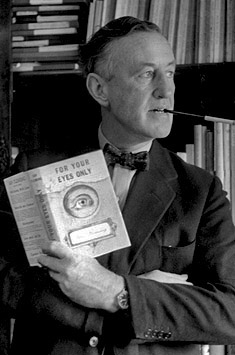 |
Some Are
Born Great
Although Johanna Harwood never met James Bond creator Ian Fleming
(1908-1964), she does have
the distinction of being the first author to parody his writing
style.
The James Bond pastiche Some Are Born Great, was first
published in the 3 September 1959 issue of Nursery World
magazine, then later reprinted in the Spring 1960 issue of
publisher Jonathan Cape's in-house magazine Now & Then [pictured
right]. Credited to J. M. Harwood (with apologies to Ian Fleming),
the short 415-word story details an intense card game, with James
Bond facing off against an unseen opponent - who turns out to be
his nanny. It is revealed that the pair have been playing the
children's card game ‘SNAP’! |
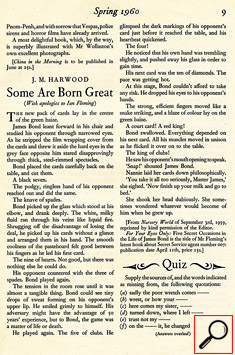 |
|
|
|
Did the choice of Sean
Connery entail any adjustments in the script of Dr. No? Did you
follow the crew to Jamaica during the shooting?
The choice of Sean Connery did not entail any changes in the script of
Dr. No. However, it was reworked a little when
Ursula Andress (imposed
by United Artists) was cast, because her physique did not match Fleming’s
heroine at all. I didn’t follow the crew to Jamaica. I stayed home in
Paris, writing the first script for Russia, which was already
scheduled to be shot in the wake of Dr. No. |
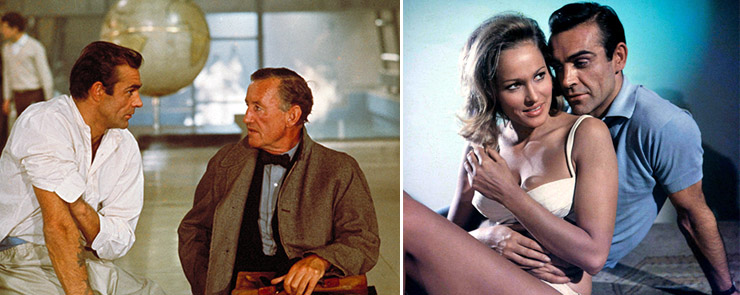 |
|
Have you followed the
Bond series over the last 60 years? What do you think of its evolution? In
what direction would you go today if you had to imagine a new Bond
adventure?
I’ve followed the Bond series somewhat randomly through television
programmes. Not enough to judge its evolution. I’m not surprised by the
scale of the Bond phenomenon: the Broccoli family has managed to keep the
same intangible qualities from film to film. I won’t allow myself to
imagine a new James Bond adventure. To each his own! |
|
“Beyond
Bond”
Johanna Harwood was born in County Wicklow in the Republic
of Ireland in 1930, and entered the film industry in 1949,
after training at Institut des Hautes Études
Cinématographiques (IDHEC) in Paris, France. Starting as a continuity
supervisor, she received her first film credit in this role
for Return To Glennascaul (1952), a short film starring
Orson Welles. The 23-minute modern-day ghost story was written
and directed by Hilton Edwards (1903-1982), and filmed in Ireland. Harwood
was then employed as assistant continuity on The Red Beret,
a 1953 British-made WWII film starring Alan Ladd (1913-1964). The Red
Beret was co-produced by Albert R. Broccoli (with his then
partner Irving Allen), and directed by Terence Young from a
script co-written by Richard Maibaum. This was followed by
Hell Below Zero (1954), once starring Alan Ladd, and
produced by Broccoli & Allen, this time directed by American
Mark Robson (1913-1978), from a screenplay adapted by Richard Maibaum.
Johanna Harwood did not receive a screen credit on these two
productions. In 1954 Harwood also worked on the British-French
comedy drama film Knave of Hearts, directed by René
Clément, who she would then marry. In 1955 Johanna Harwood
took on the job of script clerk (incorrectly credited as
Johanna Horward) on Mr. Arkadin (known in Britain as
Confidential Report) for legendary director Orson Welles. |
|
 |
|
ABOVE: (left) Poster
for the original French release of Plein Soleil
(1960) painted by Jean Mascii. Starring Alain Delon,
the crime-thriller was loosely based on the 1955 novel
The Talented Mr. Ripley by Patricia Highsmith. (right)
[L-R] Jean-Paul Belmondo, director René Clément, and Alain
Delon during the filming of Is Paris Burning? (Paris
brûle-t-il?) in 1966. |
|
|
|
René Clément
was a French film director and screenwriter who made two films
that won the Academy Award for Best Foreign Language Film -
The Walls of Malapaga (1950) (Au-delà des Grilles),
and the second two years later for Forbidden Games (Jeux
Interdits). Clément had great international success with
Plein Soleil (1960), released in the USA as Purple
Noon (1961). Co-written by Clément and starring Alain
Delon (1935- ) as Tom Ripley, the crime-thriller was loosely
based on the 1955 novel The Talented Mr. Ripley by
Patricia Highsmith. The film featured another striking poster
painted by Jean Mascii, a title sequence by future James Bond
title designer Maurice Binder (1918-1991), and a score by Nino
Rota (1911-1979). Clément was reunited with Alain Delon for
his next major film - the star-studded 1966 epic Is Paris
Burning? (Paris brûle-t-il?), written by
controversial author Gore Vidal (1925-2012) and future film
director Francis Ford Coppola (1939- ). The three-hour
black & white epic about the 1944 liberation of Paris by the
French Resistance and the Free French Forces during World War
II, was a costly box-office failure. Starring Jean-Paul Belmondo (1933-2021) - then partner of Ursula Andress (1936-
), and featuring a number of stars in supporting roles
including Orson Welles (1915-1985), and Charles Boyer
(1889-1978). All four would appear in the spoof James Bond
film Casino Royale in 1967. Is Paris Burning?
also featured Gert Frobe (1913-1988) as the military governor
of Paris. Clément began directing the British war film Play
Dirty (1969) [also know as Written in the Sand]
starring Michael Caine, but left early in production due to
disputes with producer Harry Saltzman. The film was completed
by Hungarian-American film director Andre de Toth (1913-2002).
|
|
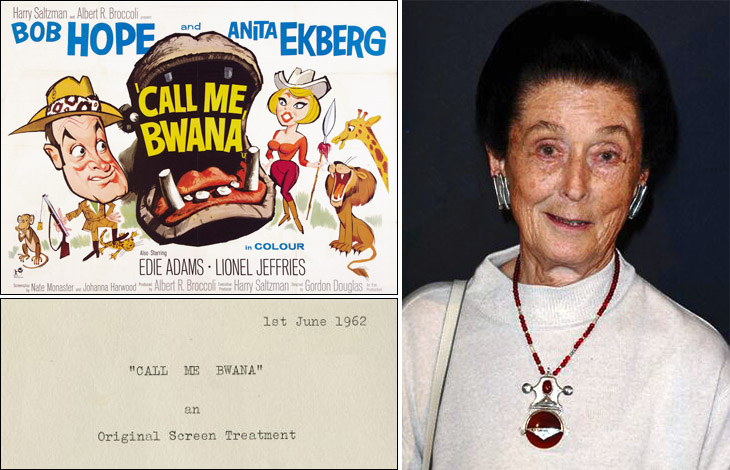 |
|
In the late
1950s Johanna Harwood was working for the talent agency
Famous Artists in
London. The American agency was founded by
Charles
K. Feldman (1905-1968), who in 1955 would acquire the
screen rights to Ian Fleming's first novel CASINO ROYALE from
director/producer & actor Gregory Ratoff (1893-1960), and produce the
1967 spoof film version. When this agency closed its
London office and Harry Saltzman
took over the tenancy, Harwood remained as his secretary and reader, even
writing two unfilmed scripts during his years at Woodfall
Productions. After working on Dr. No (1962),
Johanna Harwood then wrote the original screen treatment [and
shared screenplay credit with Nate Monaster (1911-1990)] for
Call Me Bwana (1963) made by EON Productions, and
directed by American Gordon Douglas (1907-1993). Although set
in Africa, the film was shot at Pinewood Studios. The
credits for the comedy starring Bob Hope and Anita Ekberg
reads like a ‘who's who’ of 1960s James Bond film alumni:
produced by Harry Saltzman & Albert R. Broccoli, associate
producer Stanley Sopel, Director of Photography
Ted Moore,
edited by Peter Hunt, Art Direction by
Syd Cain, assistant
director Clive Reed, dubbing editor
Norman Wanstall, special
effects by
John Stears, main titles by
Maurice Binder, and
with music & songs by
Monty Norman. Even voice artiste
‘Nikki’
van der Zyl [uncredited] dubbed Anita Ekberg as she had done
for Ursula Andress in Dr. No (1962). Call Me Bwana
was memorably ‘plugged’ in EON Productions’ next film
From
Russia With Love (1963) during the sequence where Kerim
Bey (Pedro Armendariz) assassinates Russian agent Krilencu
(Fred Haggerty), as he attempts to escape through a window
situated behind Anita Ekberg's mouth on the wall-sized poster
of his Istanbul hideout.
In 2007
Harwood created the Fondation René Clément to
commemorate her husband who died in 1996. |
|
|
|
|
“Double or Nothing”
In the year the cinematic James Bond franchise celebrates its 60th
Anniversary, 2022 also saw the publication of a new spin-off novel by Kim
Sherwood. The first in a trilogy of novels introducing a new generation of
Double-O agents, DOUBLE OR NOTHING was published in September 2022. Among
the many ‘Easter Eggs’ scattered throughout the novel for die-hard Bond
fans, is the name of one of the new Double-O agents - 003 - a certain
Johanna Harwood! The real-life Johanna Harwood is one of the few surviving
members of the original Dr. No (1962) production team, and the
first female screenwriter of the 007 series. It is fitting that one
of the chief architects of the James Bond series, and someone who played
an important part in the success of the first two films, can now be recognised for her lasting
contribution to the long-running franchise.
2024 RTÉ interview with Johanna Harwood |


